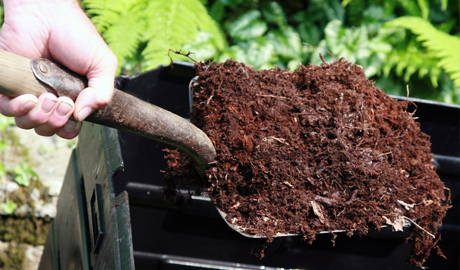Composting

How to Compost
Composting is the simple natural process of decaying plant and animal wastes into a loose peat-like humus. Composting is a time saver because it solves your surplus trash problems. It saves money that you would otherwise spend on fertilizer because finished compost is one of the most complete plant foods known. Best of all, by composting and reusing waste materials, you will be doing your share in protecting the environment.
It’s easy to learn how to compost. Here’s how composting works . . .
Natural decay causing bacteria that live in the soil feed upon and digest plant and animal wastes. This releases heat which speeds up the process of decay. Depending on how you treat your compost pile, it takes 6 weeks to 6 months to make finished compost.
How to Build a Compost Pile
Pick a spot in the garden that is somewhat secluded. Put a 6 – 12 inch layer of waste material on the ground about 4 feet wide and 6 feet long. Over this layer scatter one or two pounds of lawn or garden fertilizer. Better yet, use a commercial compost starter. This hurries the process of decay and forms a richer compost. If the material that is used is dry, dampen it with water to the wetness of a squeezed sponge.
Over the top of this, sprinkle a 1 or 2 inch layer of ordinary topsoil. Keep adding layers until the pile is 4 feet high. The pile can be enclosed by a cement block wall or an open mesh fence. Let it set for 6 months and it will be ready for use.
Materials to Use in Making Compost
You can use grass clippings, leaves, weeds, sod, fall garden waste, shredded newsprint, kitchen waste of vegetable origin, tree trimmings, animal manure, etc. You can collect sawdust, hay, straw, and factory byproducts of plant and animal origin, such as shells and hulls, tankage, and dried blood.
How to Use Finished Compost
The use of compost is the key to natural gardening. Compost loosens and aerates hard clay soils and builds up sandy ones. It also helps sandy soils hold water. Compost slowly releases its many nutrients for plant use. It also activates beneficial soil organisms.
• Use it to build up the soil by working in a 2 inch layer into flower beds and vegetable gardens.
• Use it to mulch around established plants.
• Use it as top dressing for your lawn.
• Mix it with an equal quantity of topsoil to be used as potting soil, or tree planting mix.
• Use it as plant fertilizer by side dressing growing plants.
How to Speed Up the Composting Process
To work properly, compost piles need air, moisture, and heat in moderate quantities. Here’s how you can achieve the best condition for quick composting:
• Grind or shred all materials to be composting.
• Turn the pile once a week until it’s done.
• Make sure the pile does not dry out.
• Raise the pile off the ground on a screen for better aeration.
• Use starter cultures of bacteria available commercially.
Other Methods of Composting
Sheet Composting: Instead of composting it in a pile, the waste material is spread over the garden in a 3 to 6 inch layer. It is best to shred the materials before spreading. Fertilizer should be broadcast next, at the rate of 1 – 2 lbs. per 100 square feet. Then mix with the soil by rototilling or spreading.
Anaerobic Composting: The previous composting methods are aerobic methods. This simply means that the decay causing organism needs air to do the job. A different type of bacteria is at work in the anaerobic or airless method, but achieves the same result. To compost anaerobically, a black plastic cover is used to seal the pile completely. The edges are
held to the ground with dirt. This method eliminates all odors, flies and rodents. No watering or turning is necessary. Composting is usually complete in 3 months.
